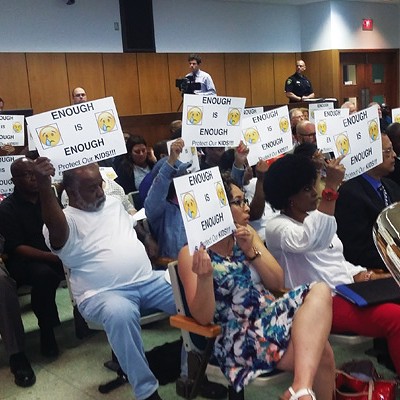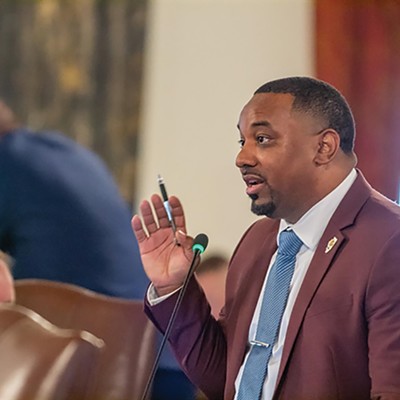
A popular Springfield middle school slated for closure may get a second chance at an upcoming school board meeting, based on public outcry and disputed cost-savings estimates.
At the Feb. 18 meeting of the Springfield Public Schools Board of Education, board member Bill Looby disputed the $1.7 million savings estimate associated with closing the Capital College Preparatory Academy, 1101 South 15th St. Looby said the actual savings would likely be between $1 million and $1.1 million, and he garnered applause from the audience when he stated that he planned to seek a revote on whether to close the school.
“I don’t want to come across as a sore loser, but I do think it looks like we voted on something that probably overestimated savings to the (education) fund by a third,” Looby said. “I don’t know if anyone’s mind has changed due to the smaller amount of savings and what I deem as the importance of the school.”
CCPA is an alternative middle school that focuses on science, technology, engineering and math – known as “STEM” curricula – to prepare sixth, seventh and eighth grade students for college. The school last year posted test scores that were 14 points higher than the district average and four points higher than the state average. The school board created CCPA in 2010 as a means to help close the “achievement gap,” which refers to test score disparities between students of different races and socio-economic standing. Its student body of about 200 “scholars” is comprised of about 52 percent African-American children, with about 77 percent of all students classified as coming from low-income households. That led some members of the school board and the public to question whether the closure of CCPA was motivated by race or class.
David Milling says that’s not the case. Milling is the chair of the Community Budget Review Committee, a group of community members appointed by the school board to find possible areas to cut from the school district’s budget. It was that committee which proffered the $1.7 million savings estimate for closing the school. He notes that the proposal to close the school was originally put forward by outgoing district superintendent Walter Milton in March 2012. The administration later declined to support the proposal in materials given to the school board for consideration on cuts.
Milling says that rather than proposing the closure of CCPA based on race and class, the committee originally hoped to consolidate CCPA, Iles School and Springfield Ball-Charter into the remaining middle schools. CCPA was targeted because the school was no longer enough of an alternative to justify its cost, Milling says. Other schools like Jefferson Middle School have adopted elements of CCPA’s approach, such as single-gender classrooms, Milling says, while CCPA no longer offers elements that contributed to its success, including smaller class sizes and Saturday teaching.
CCPA principal Chris Colgren says the school still retains unique elements that make it a good fit for students who have had academic trouble at traditional schools. He points to the school’s differently-structured school day and STEM focus, as well as its “philosophical mindset.”
“This is a program that some children are really able to have success with. I believe that what we’re doing is still fundamentally different from every other middle school in town.”
But for David Milling and others, the CCPA closure still comes down to cost. CCPA wasn’t supposed to raise the district’s costs, Milling says, pointing to the minutes of the March 2, 2010, meeting at which CCPA was created. Milling says the district’s income has actually increased by about $11 million since 2009, but expenses have risen $18 million over the same period. Milling says updated numbers from the district show closing CCPA would save $1.3 million after accounting for reassigned teachers and transportation costs.
Correction: A previous version of this story said the revised total savings is $1.1 million instead of $1.3 million.
Bob Leming, interim superintendent for the school district, says 8 to 10 teachers currently at CCPA may have to be moved to other schools once CCPA is closed to keep class sizes under the limit of 33 students.
Joe Bascio, interim director of business services for the school district, says retaining teachers will subtract from the projected savings of closing CCPA. To estimate the cost of personnel, the district multiplies the average teacher salary of $51,000 by the number of teachers, Bascio says. That could mean a reduction in savings of between $408,000 and $510,000.
During the Feb. 18 school board meeting, CCPA principal Colgren offered his own analysis of the possible savings associated with closing the school. Based on where students live, Colgren estimated that 34 would transfer to Franklin Middle School, 29 to Grant Middle School, 63 to Jefferson Middle School, and 94 to Washington Middle School. That means between nine and 11.5 teaching positions would be needed collectively at those schools, Colgren noted, whereas the district recommended cutting CCPA’s teaching staff to 16.5 positions. Colgren said the difference in savings between reducing CCPA’s staff and closing the school entirely amounts to between $609,400 and $736,900.
School board member Bill Looby says his revote motion will be on the agenda at the next meeting on March 5. He says the closure of CCPA “didn’t get the same amount of attention and discussion over the course of time that the district’s recommendations did.”
“We never got a full accounting for that cut,” Looby said. “This school is one that was put forward to address the ills in our education system. Whether or not anyone will change their minds, I just think we need to have a more in-depth discussion.”
Contact Patrick Yeagle at [email protected].




















